Attract New Listeners With Your Podcast Episode Descriptions
How We Make Mobycast - Part 3
If you’ve ever thought about how you want your show to look to new listeners vs long-time subscribed listeners, this post is for you. It’s worth reading if you’ve put some time into your podcast and want to draw in more listeners by fine tuning everything you can about your show. It turns out that the Apple Podcasts App shows different things to people searching vs people subscribing, and there’s a ton of inconsistency around how popular hosting providers handle them too. Read on if you’d like to get into the details with me.
Just to whet your appetite, there will be a showdown between four of the most popular hosting providers:


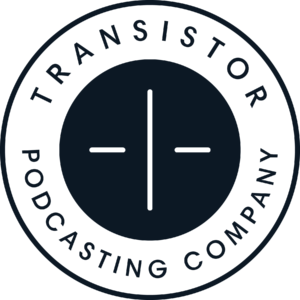
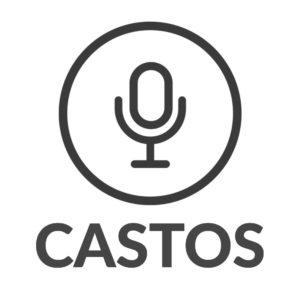
When Chris Hickman and I, Jon Christensen, started our podcast in 2017, we had no idea there was so much to learn about podcasting. How hard could it be? You have a really interesting conversation for an hour, put some music on either end of it and throw the file on some hosting service. Step 3, profit!
We were so wrong, and in this series, I’ve been documenting some of the lessons we learned in hopes that it can help other podcasters avoid learning them the slow (hard) way.
In this installment, I thought I was going to be so smart and tell you this ultra obscure thing that we learned that made our show so much better. But as I started writing it, I realized that I what I thought I knew was wrong! We may still have some adjustments we want to make. But I’m getting ahead of myself.
First, what is this post even about? I’m going to talk about the fields your hosting provider has when you add an episode and how they change what people see in the Apple Podcasts app. I’m not going to get super technical, but I am going to geek out hard over some wildly obscure ways the most popular podcast player in the world behaves that could have a real impact on whether people decide to listen or not.
By the end of this post, you will know some things about how the Apple Podcasts app works with your hosting provider that I would bet most podcasters don’t know. This is pro-level stuff and will help you think about how people approach your podcast.
In mid 2019, I was minding my own business at my home office desk doing some very important work when I got a message from my co-host. It said “I’ve been looking at our RSS feed, and have some questions…” Then there were three questions written in boring-ese, and so I ignored the message and went on with my day as though Chris didn’t even send it.
I think another two or three weeks went by and then our producer (Rich Staats), Chris, and I were in a meeting together – we all work remotely, so it was a Zoom meeting – and Chris decided he’d had enough of this silence and asked his question again. Much harder to ignore on the Zoom meeting. By this point, Chris’s questions had turned to an accusation (which is really what it was from the beginning). Chris had noticed that there may be some features we weren’t taking advantage of when listing episodes in the Apple Podcasts app. He thought it was because we weren’t properly using our hosting provider.
Really? What features? We were filling out all the fields in Castos, so what was Chris talking about? Chris had piqued my curiosity. Immediately I noticed that the Apple Podcasts app was doing some weird stuff. Searching for popular podcasts and looking at the ones I already had in my library, I noticed inconsistencies.
Here’s a popular show I found by searching:
Search Tab – Pod Save America

There’s the section at the top with the play button, then a light gray line, and then an episode summary. In the summary there might be links.
So there’s nothing confusing about that. But now here’s the exact same episode in the exact same app, but now it has the heading “Episode Notes” above it! What changed?
Library Tab – Pod Save America
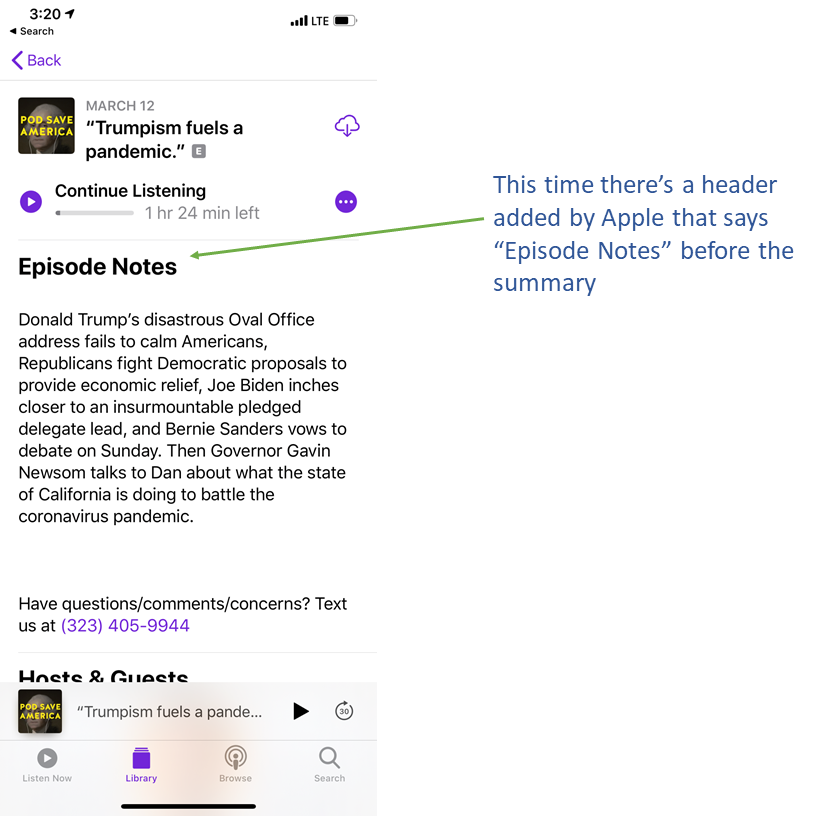
It took me forever to figure it out. But here’s what changed. In the first picture, we’re looking at the episode details view as a non-subscribed person from the Search Tab in Podcasts, and in the second picture we’re looking at the episode details as a subscribed person from the Library Tab in Podcasts.
The Search Tab and the Library Tab’s views of an episode are different? Why Apple!? Why!?
As someone that has spent the better part of my lifetime designing software, that’s a little too subtle for my liking. But in this first case, it doesn’t really matter. One of the views says Episode Notes and the other one doesn’t. So what?
Well here’s where it gets TERRIBLE. Here’s another podcast episode the someone would see from in their Library view:
Library Tab – Devops and Docker

We have more information on the screen for this episode. The episode summary is at the top, and then the header “Episode Notes” and then the episode description that contains links below that. This seems like it might be great. So much more juicy information about your episode for people to read and consume. But here’s the same episode that an unsubscribed person would see from the Search Tab.
Search Tab – Devops and Docker

Oh no! So much information gone! No hyperlinks! This is just awful. For some reason, absolutely unknown to me, Apple has decided to not show the Episode Notes when you’re in the Search view.
This means that people who probably don’t subscribe to your podcast may not be seeing everything you painstakingly wrote about your episode when they do a search for it.
It also seems to be related to including or leaving out a summary. This is so confusing. Who would ever think “oh I’m going to leave out the summary”?
And now we’re back to what I was saying at the beginning of the article. I thought I had been so clever by discovering that Castos wasn’t giving you the ability to have both a description and a summary. And I thought this article was going to be able making sure to pick a hosting provider that includes all the fields that the Podcasts app allows you to use. But no! Time to put your nerd costume on, we’re going to geek out!
To figure all this out, and to know what to do, we have to take a look at some hosting providers. Here are the new episode pages for 4 different hosting providers followed by the RSS feed for each. I’ve added a couple notes, but you can just scan this real quick. It’s the details for people that want to dive deep.
Investigating the Hosting Platforms 🤓
First Transistor
This is the hosting platform we’ve been using at Mobycast.

I’ve highlighted where the values of these fields end up in the RSS (note that I removed a bunch of stuff from the RSS to make it kind of readable). Skip right over this if you don’t generally read code. It’s not important to understanding the article.
<item>
<title>Waiting for COVID-19 and flows</title>
<author>Jon Christensen</author>
<pubDate>Tue, 24 Mar 2020 09:00:00 -0700</pubDate>
<description>In the first installment, Jon talks about how we're in the waiting game now but a couple spots are starting to show life around the state.</description>
<content:encoded>
<![CDATA[
In the first installment, Jon talks about how we're in the waiting game now but a couple spots are starting to show life around the state.<br><br>Namely
<ul>
<li>Dave's Wave</li>
<li>Montrose Wave</li>
</ul>
]]>
</content:encoded>
<itunes:title>Waiting for COVID-19 and flows</itunes:title>
<itunes:subtitle>In the first installment, Jon talks about how we're in the waiting game now but a couple spots are starting to show life around the state.</itunes:subtitle>
<itunes:author>Jon Christensen</itunes:author>
<itunes:summary>In the first installment, Jon talks about how we're in the waiting game now but a couple spots are starting to show life around the state.</itunes:summary>
</item>
Next up is Castos
We used to use Castos to host Mobycast and changed because we felt we needed better control over the data in our RSS feed
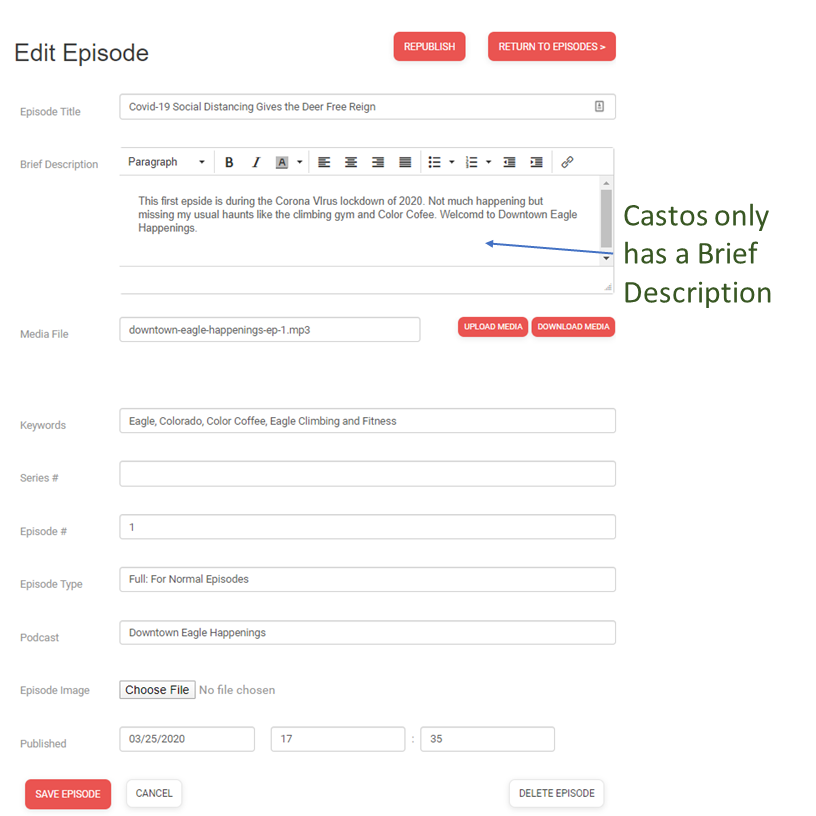
Again I’ve highlighted where the values of this one field ends up in the RSS You might notice that Castos just copies this one field into all three places in the RSS. Skip right over this if you don’t generally read code. It’s not important to understanding the article.
<item>
<title><![CDATA[Covid-19 Social Distancing Gives the Deer Free Reign]]></title>
<pubDate>Wed, 25 Mar 2020 17:35:00 +0000</pubDate>
<description><![CDATA[
This first epside is during the Corona VIrus lockdown of 2020. Not much happening but missing my usual haunts like the climbing gym and Color Coffee. Welcome to Downtown Eagle Happenings.
<a href="https://eagleoutside.com/">https://eagleoutside.com/</a>
]]></description>
<content:encoded>
<![CDATA[
This first epside is during the Corona Virus lockdown of 2020. Not much happening but missing my usual haunts like the climbing gym and Color Coffee. Welcome to Downtown Eagle Happenings.
<a href="https://eagleoutside.com/">https://eagleoutside.com/</a>
]]>
</content:encoded>
<itunes:title><![CDATA[Covid-19 Social Distancing Gives the Deer Free Reign]]></itunes:title>
<itunes:subtitle><![CDATA[This first epside is during the Corona Virus lockdown of 2020. Not much happening but missing my usual haunts like the climbing gym and Color Coffee. Welcome to Downtown Eagle Happenings. https://eagleoutside.com/]]></itunes:subtitle>
<itunes:author><![CDATA[ Jonathan Christensen ]]></itunes:author>
<itunes:summary><![CDATA[This first epside is during the Corona Virus lockdown of 2020. Not much happening but missing my usual haunts like the climbing gym and Color Coffee. Welcome to Downtown Eagle Happenings. https://eagleoutside.com/]]></itunes:summary>
</item>
Third is Buzzsprout
We’ve never used Buzzsprout, but they appear to be very popular and were a big hit at the recent Podfest 2020 conference in Orlando.
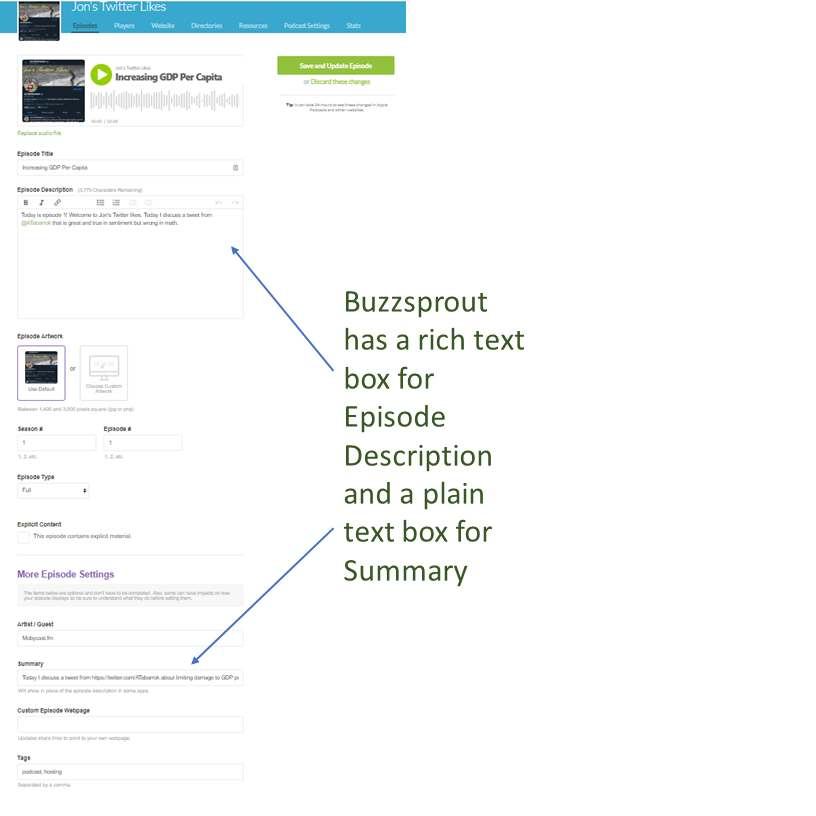
Just like Transistor, Buzzsprout copies the rich text field into different places in the RSS feed than the plain text field, but which one goes where is slightly different.
<item>
<pubDate>Tue, 24 Mar 2020 15:00:00 -0400</pubDate>
<title>Increasing GDP Per Capita</title>
<description><![CDATA[
Today is episode 1! Welcome to Jon's Twitter likes. Today I discuss a tweet from <a href="https://twitter.com/ATabarrok">@ATabarrok</a> that is great and true in sentiment but wrong in math.
]]></description>
<content:encoded>
<![CDATA[
Today is episode 1! Welcome to Jon's Twitter likes. Today I discuss a tweet from <a href="https://twitter.com/ATabarrok">@ATabarrok</a> that is great and true in sentiment but wrong in math.
]]>
</content:encoded>
<itunes:title>Increasing GDP Per Capita</itunes:title>
<itunes:author>Mobycast.fm</itunes:author>
<itunes:summary>Today I discuss a tweet from https://twitter.com/ATabarrok about limiting damage to GDP per capita</itunes:summary>
</item>
Last is Captivate
They are newer, good at marketing, and were VERY popular at the Orlando Podfest 2020 conference.
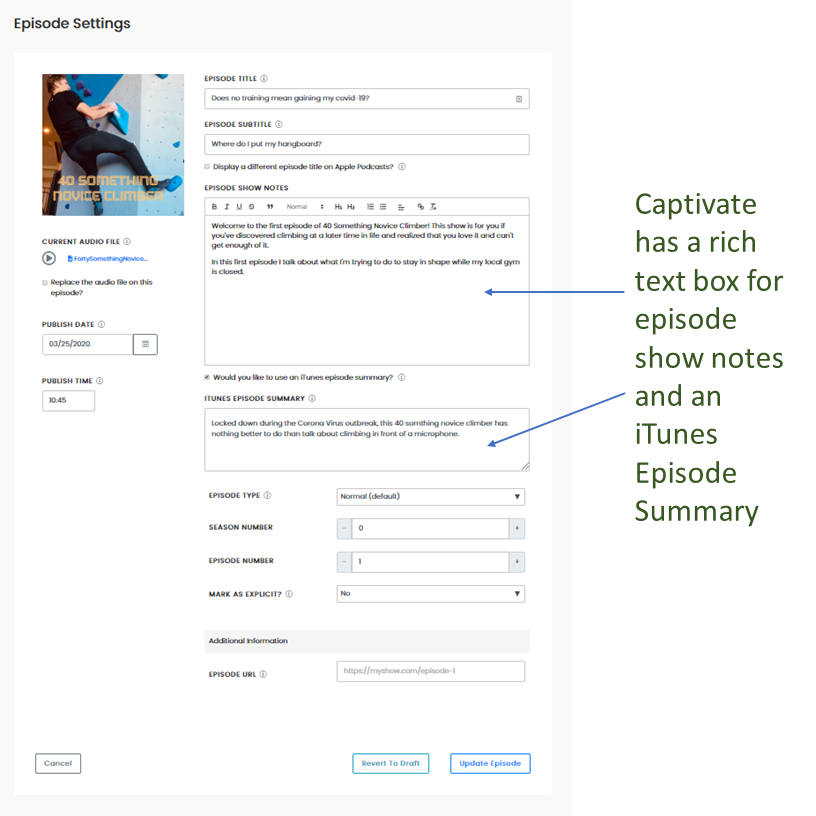
They chop up the RSS exactly the same way as Buzzsprout.
<item> <title>Does no training mean gaining my covid-19?</title> <pubDate>Wed, 25 Mar 2020 16:45:00 GMT</pubDate> <description>Welcome to the first episode of 40 Something Novice Climber! This show is for you if you've discovered climbing at a later time in life and realized that you love it and can't get enough of it. In this first episode I talk about what I'm trying to do to stay in shape while my local gym is closed.</description> <content:encoded> <![CDATA[ Welcome to the first episode of 40 Something Novice Climber! This show is for you if you've discovered climbing at a later time in life and realized that you love it and can't get enough of it. In this first episode I talk about what I'm trying to do to stay in shape while my local gym is closed. ]]> </content:encoded> <itunes:title>Does no training mean gaining my covid-19?</itunes:title> <itunes:author>Mobycast.fm</itunes:author> <itunes:summary>Locked down during the Corona Virus outbreak, this 40 something novice climber has nothing better to do than talk about climbing in front of a microphone.</itunes:summary> </item>
All Four Hosts Distilled
There’s too much to take in here. Too much code and confusion. So I’ve boiled this all down into a table

In this table, green cells are the one where the hosting platform tells you it’s a short summary of your episode and the yellow ones are the ones where the hosting platform tells you it’s the detailed episode notes. The bolded cells are the ones where the hosting platform lets you put in rich text like bullet points, bold, italics, and links.
The Search Tab🔍
Now let’s see how these four podcasts look in the Search Tab of the Apple Podcasts app:
Transistor in the Search Tab – All Fields Filled Out

Castos in the Search Tab – All Fields Filled Out
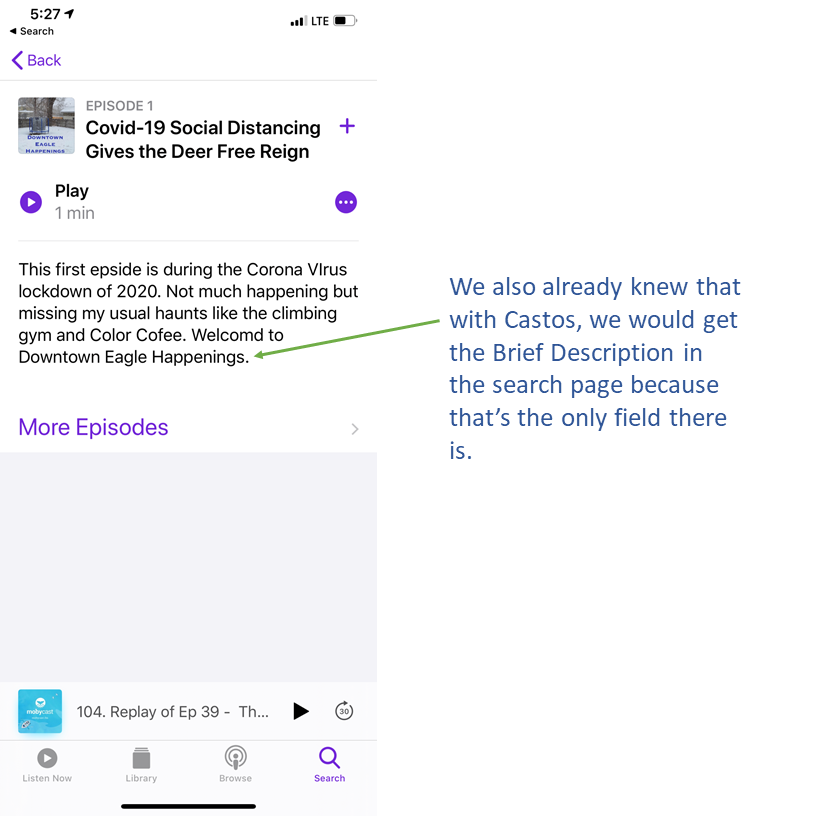
Buzzsprout in the Search Tab – All Fields Filled Out
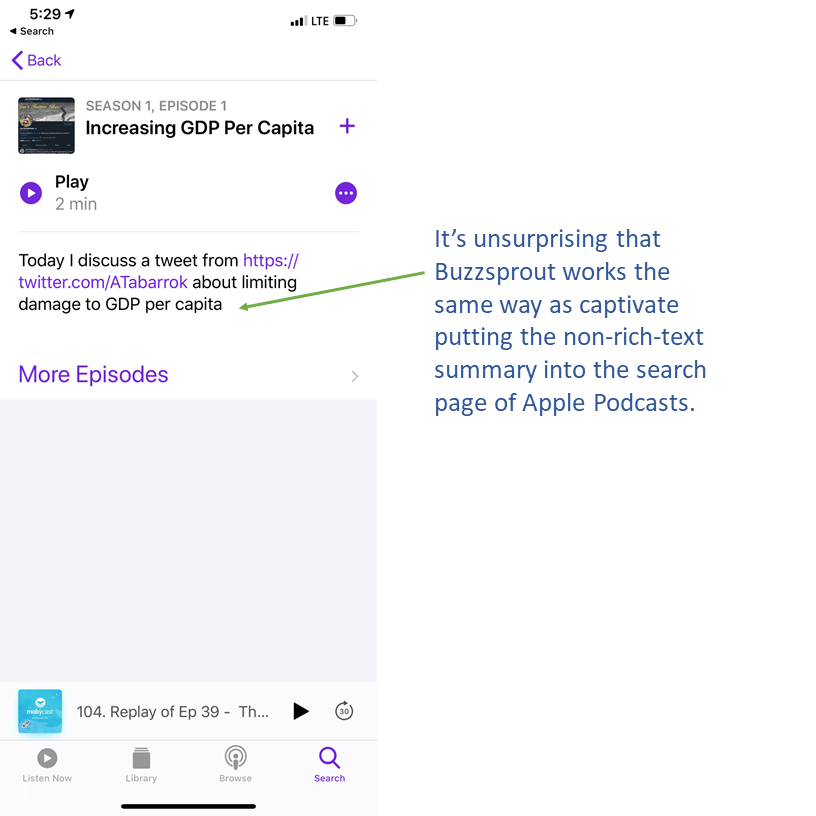
Captivate in the Search Tab – All Fields Filled Out
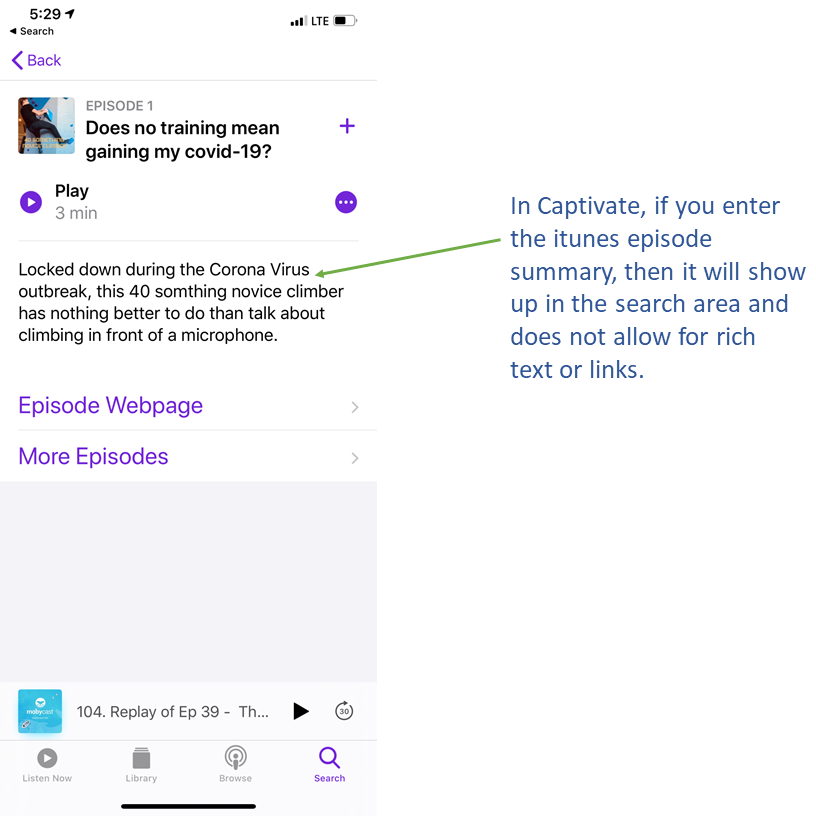
None of this was surprising. We kind of figured that the ‘itunes:summary’ part of the RSS feed was specifically for the view that you see when you look at the search results and drill into an episode from there. Sure enough, in all 4 cases, what’s in that part of the feed is what we see. There is one surprise! A link in that part of the summary becomes an active link! That’s helpful for sure.
This wasn’t quite what I wanted to get to. The real questions I had were two-fold:
- What happens in Captivate and Buzzsprout when I don’t put something in the iTunes summary field?
- Is it possible for me to get hyperlinks and rich text into the search view of the Apple Podcasts app for my episode?
The answer to the first question is intuitive and what you would expect. If you don’t put the summary field into Buzzsprout or Captivate, then the search view shows your Episode Show Notes (Buzzsprout) or Episode Description (Captivate). More simply, it shows the stuff you put in the big text field with the rich text editor.
Here’s an example from Captivate:
Captivate Search Tab – No Summary
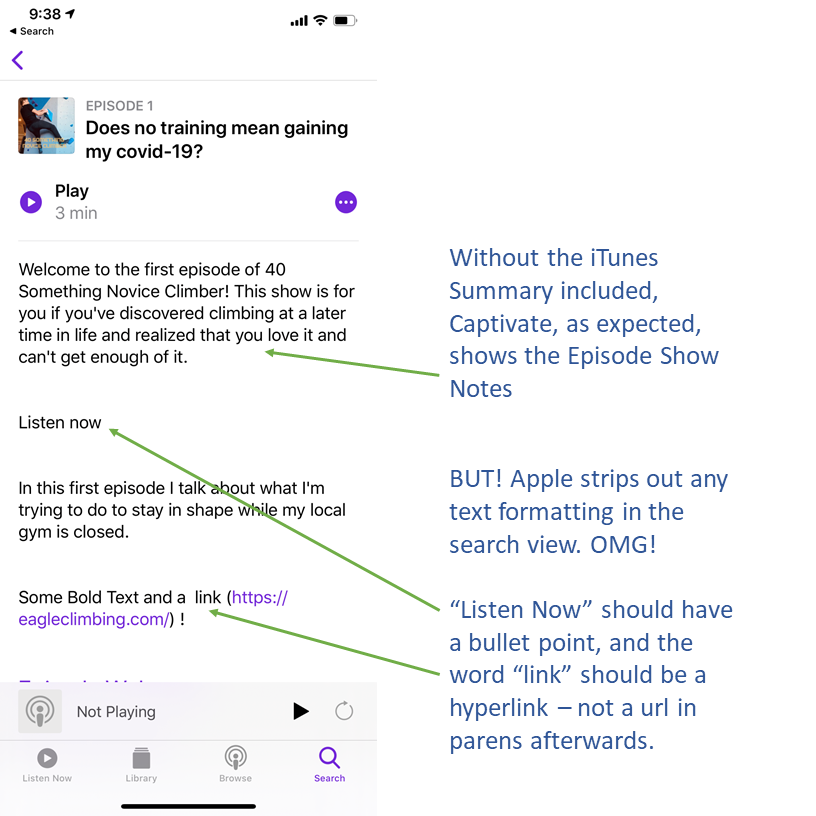
From this Captivate example, we get our answer to question two. No, in the search view of an episode you cannot get richly formatted text. No formatted links, no bullet points, nothing.
So my conclusion for getting the absolute best possible experience for users viewing individual episodes from the Apple Podcasts app is to not try to get any richly formatted text into them. But do go ahead and put some urls, phone numbers or email addresses in there. They’ll be clickable, and that’s a win. It also seems like Captivate and Buzzsprout offer the best flexibility for whether you want to have a different view of your episodes in the Search Tab vs from the Library Tab (which I would argue is probably not a good idea for most podcasts). But there’s a final plot twist at the end!
The Library View
To get to our plot twist, let’s see how each of the four hosting platforms look in the Library Tab with and without the summary field.
Transistor Library Tab — with Summary
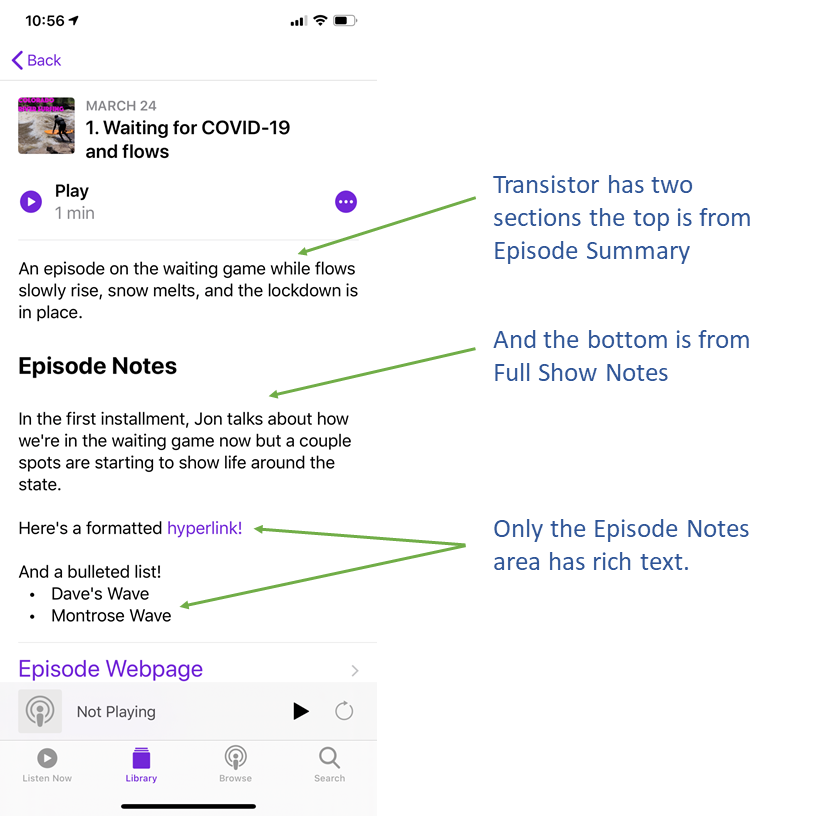
Castos Library Tab — Summary n/a
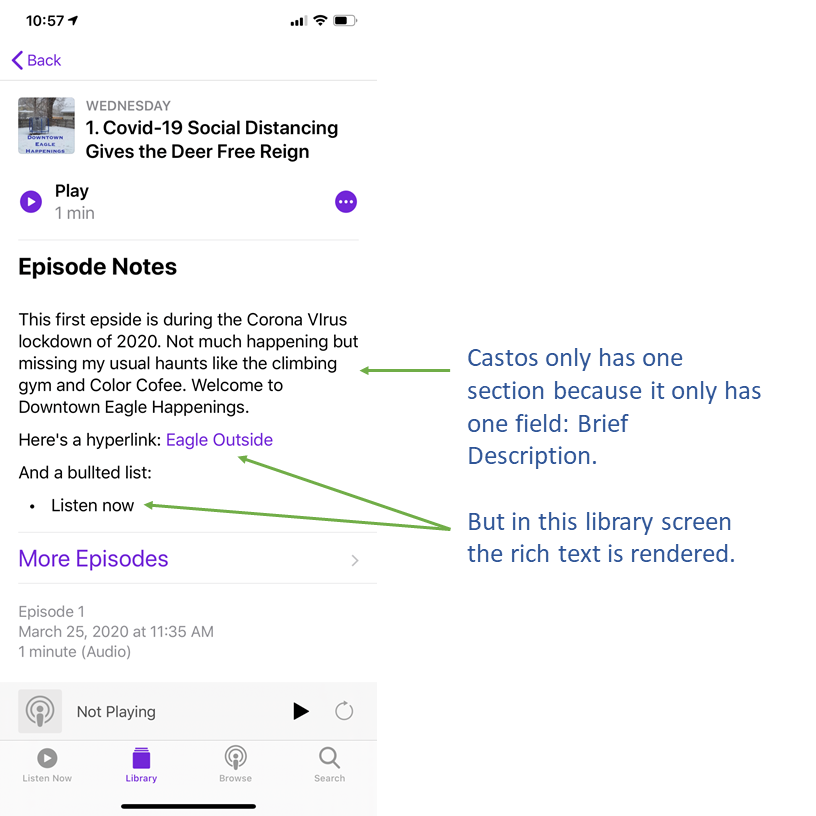
Buzzsprout Library Tab — with Summary
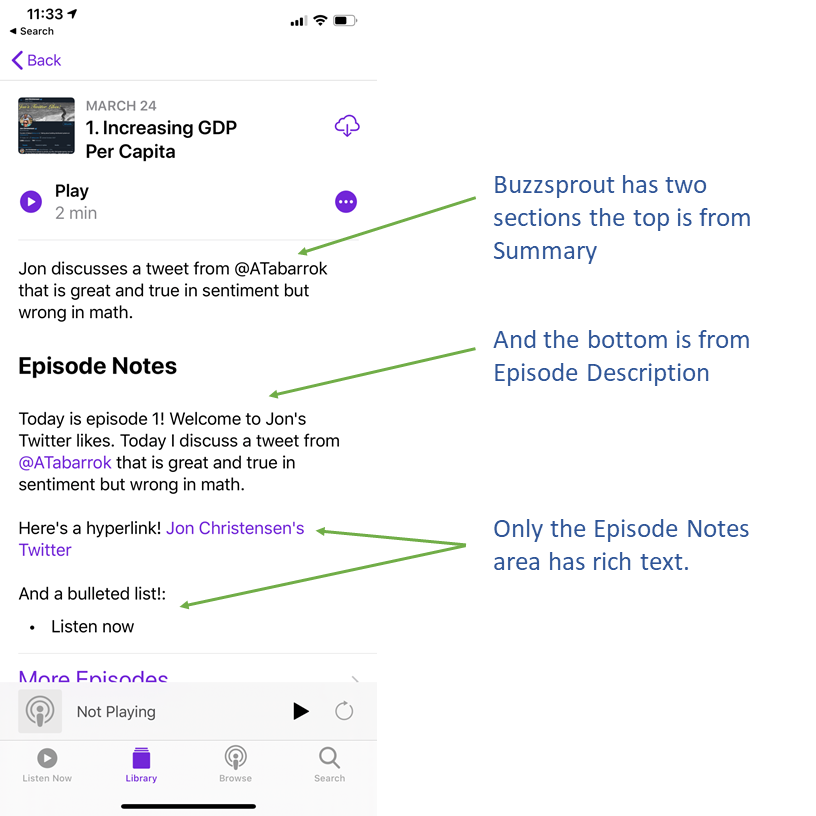
Captivate Library Tab — with Summary
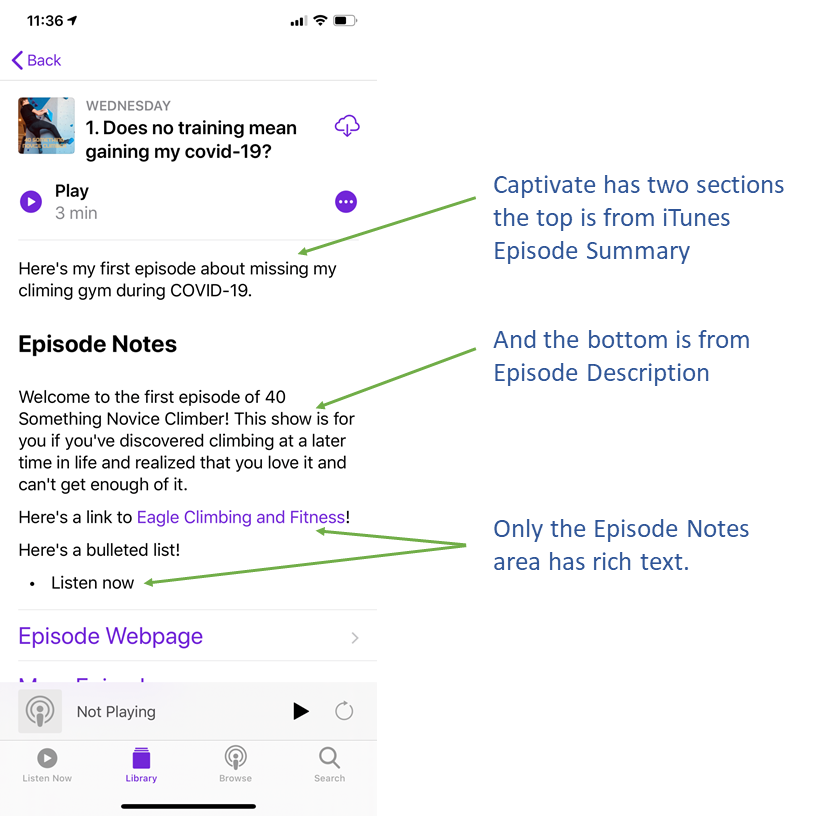
All of these examples (minus Castos) unsurprisingly show two sections where the top one is plain text and the bottom one is rich text. Exactly what we expected. So now what happens if we remove the summary field from each of the three hosting platforms that provide it (Transistor, Buzzsprout, and Captivate)? Based on the table above that shows that Transistor maps the fields a little differently than Buzzsprout and Captivate, my hypothesis is that we’ll see a difference. 🤓
Transistor Library Tab – No Summary
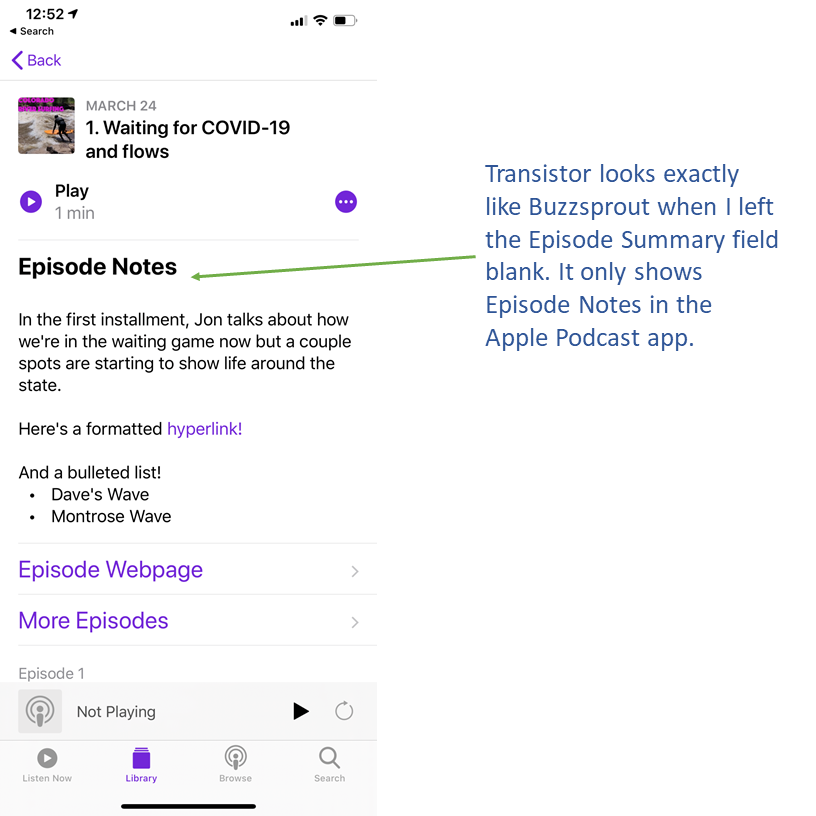
Buzzsprout Library Tab – No Summary
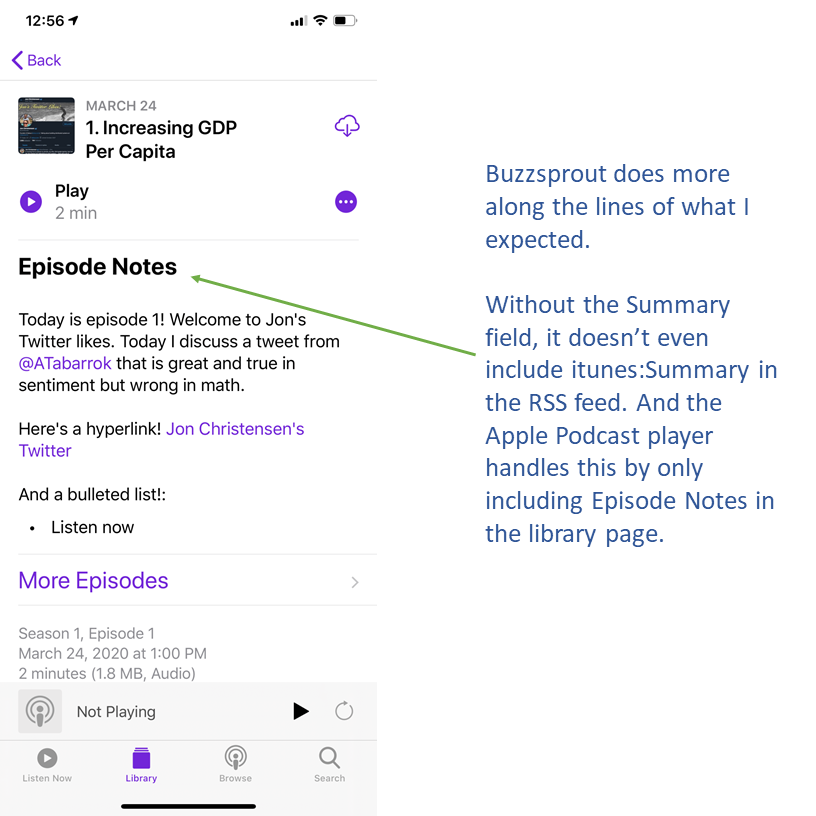
Captivate Library Tab – No Summary
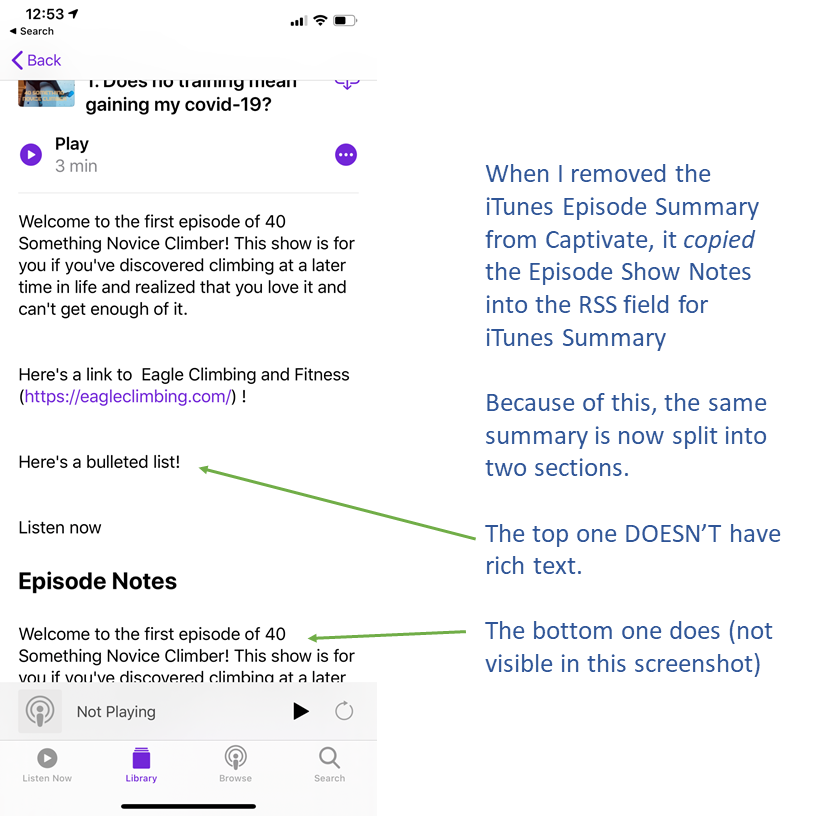
So there was a difference, but I expected Transistor to be the odd one out, not Captivate! When you leave out the iTunes Summary field in Captivate, they still put one into your RSS feed, but they fill it with the text from your Episode Show Notes! Captivate’s decision strikes me as a bit surprising and it’s unfortunate that it leads to a doubling of the Episode Notes when viewing an episode from the library.
Is this the plot twist that I promised? No! Well it is a twist, but not the one I was leading towards. There are two more things to see before we get to the plot twist. The next big question is this: Now that we’ve removed the summary fields from the three hosting platforms that provide it as an option, will we have changed the way things look in the Search Tab? I’ll spare you from looking at three more screenshots. Just so you know, Captivate and Buzzsprout look exactly the same as they do above in the section called “The Search Tab“.
It’s Transistor that is different and not in a good way 😲.
Transistor Search Tab – No Summary
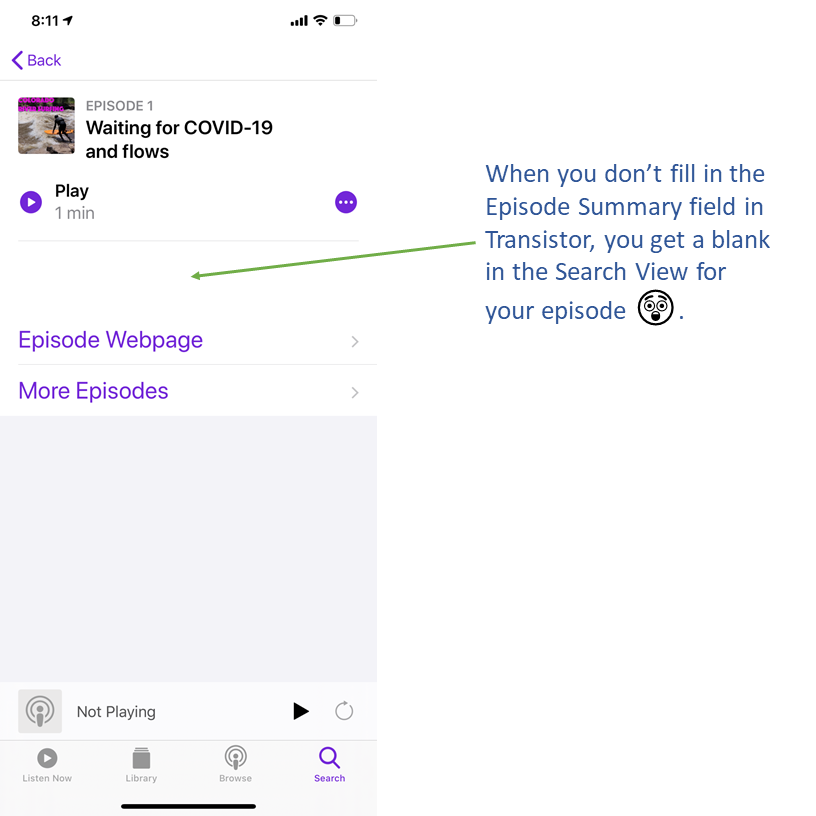
When I realized this I was about to throw out Transistor completely as an option! It felt like Transistor was forcing me to add an iTunes summary, and Jon doesn’t take lightly to getting forced to do anything. I’d rather do it like the podcasts that just have a single Episode Notes field — keep it clean and simple. That would have left the only good hosting options as Castos or Buzzsprout.
But here it is, the plot twist we’ve all been waiting for. It turns out that there’s a secret magic feature of the Apple Podcasts app, and it’s pretty neat. Let me see if I can clearly explain it. So in Transistor, Captivate, or Buzzsprout, if you put in an Episode Summary and Full Show Notes, and the Full Show Notes start with the same text as your episode Summary, you get this cool outcome where Apple Podcast merges the two into one. Let me just show you so you can see what I mean.
First here’s how I filled out the fields in the screen.
Transistor – Filling out an episode to use the magic feature
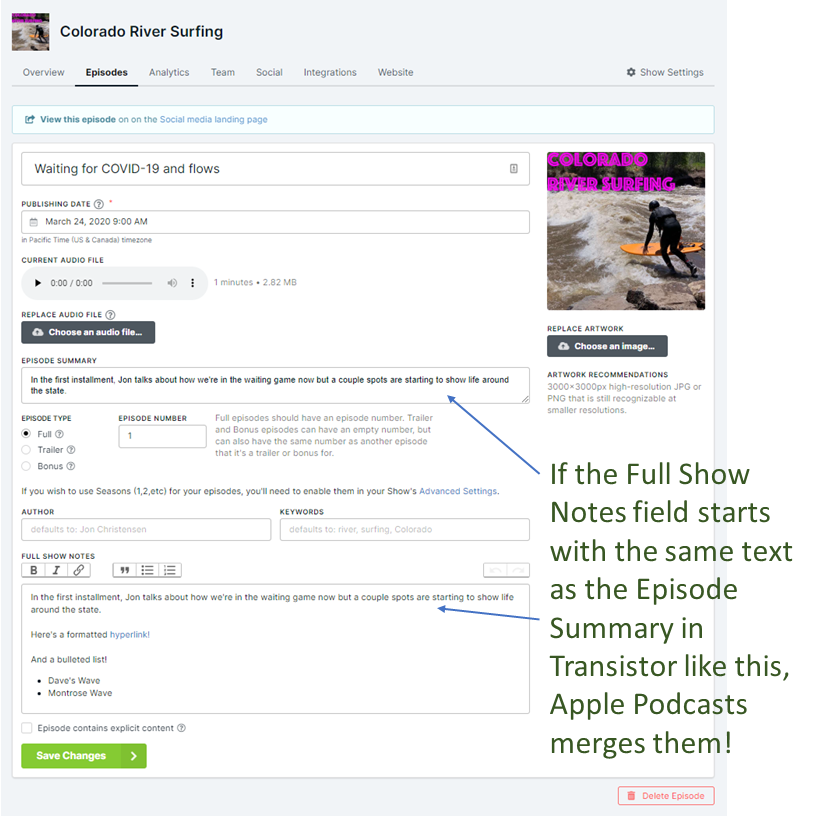
Now here’s the Search View that shows just the Episode Summary.
Transistor – Search Tab with Summary Clipped From Full Episode Notes
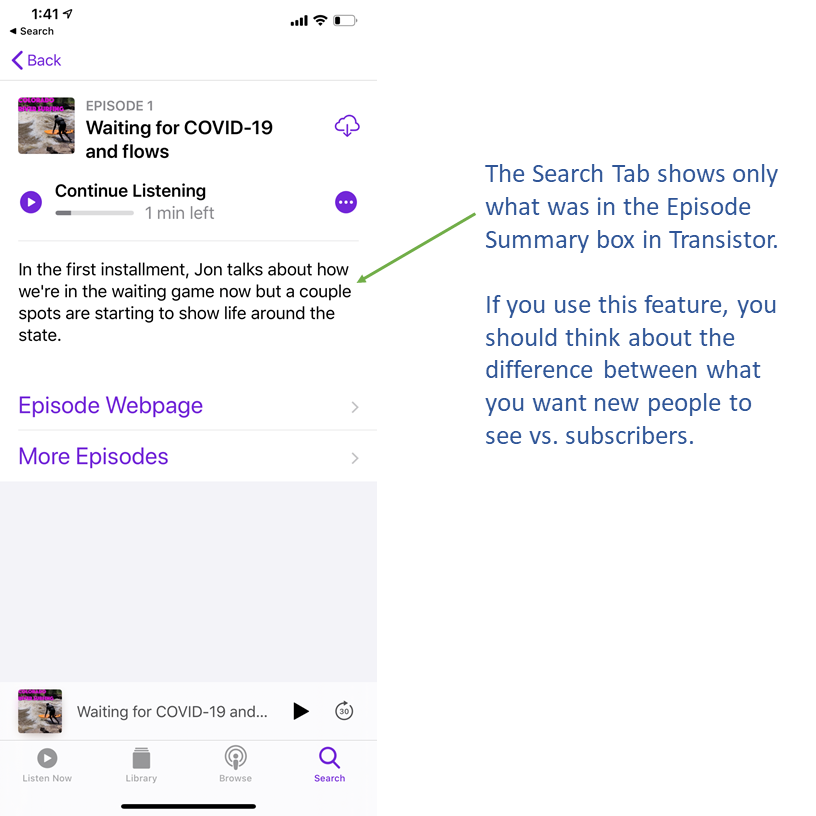
And finally here’s the Library View of the same episode. No extra summary section above the Episode Notes section! It’s Apple Podcasts magic!
Transistor – Library Tab with Summary Clipped From Full Episode Notes
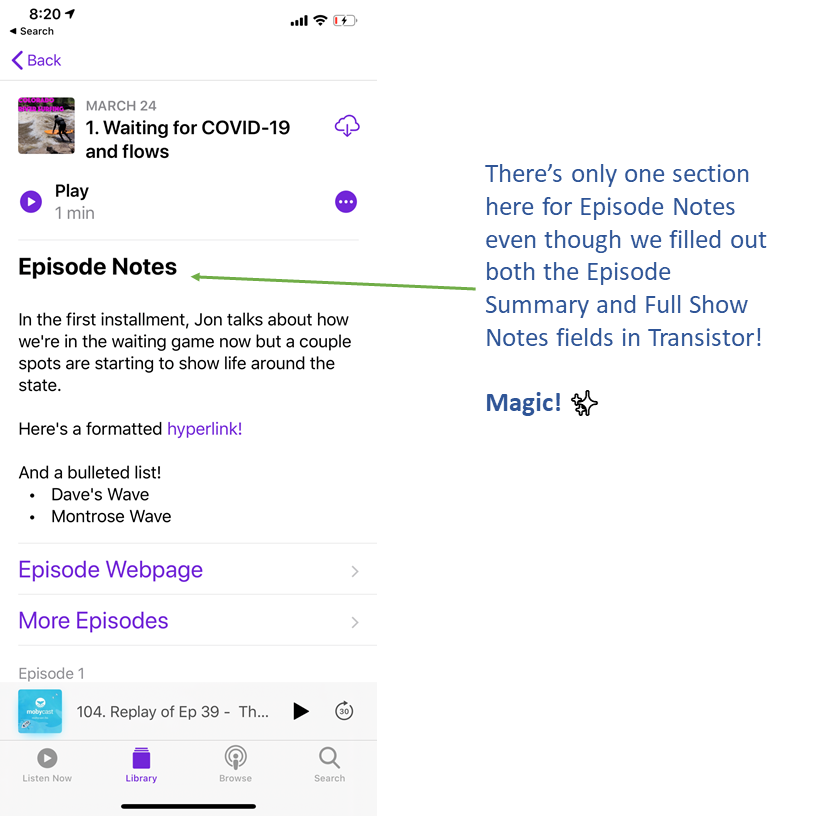
This final solution with the expanded Episode Notes having a bit more rich text and episode information is the ideal solution for many podcasts that want to engage just a bit more with their subscribers and may want to ask them to join mailing lists or subscribe to a private feed. And since it can be done in a single, clean Episode Notes field, I think it’s the easiest to read.
Conclusion
Of the four hosts that I tested, all four can work well at creating an RSS feed. But only one works intuitively in every scenario. Buzzsprout!
Here’s a table so you can see what I mean:
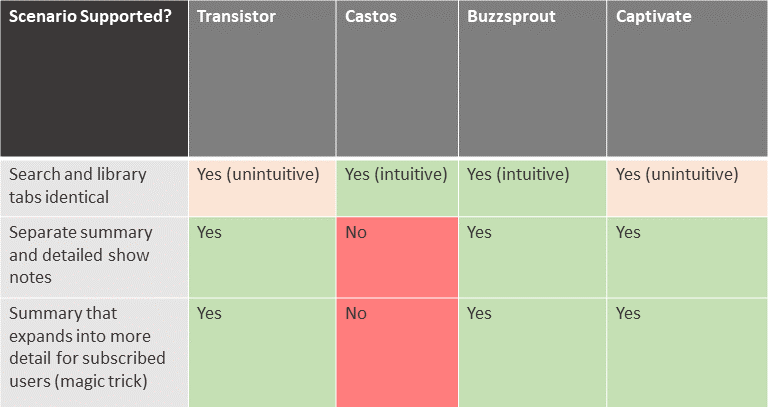
The orange boxes that say ‘unintuitive’ mean that you can get the Search Tab to match the Library Tab, but you have to put the exact same text into both the summary field and the description field, and, reading the information on the form, you wouldn’t know that. I mark Buzzsprout as intuitive, because it shows the iTunes Summary as an optional field, and if you don’t fill it in, it makes your Search Tab match your Library Tab, which feels right.
Here’s my suggestion: I think it’s best to show as little as possible with the goal of enticing someone to listen in show notes. Podcast app users aren’t there to read. Just having one field for Episode Notes in the Apple Podcasts app is clean and simple. Therefore, I recommend everyone use the magic trick in Transistor, Captivate, or Buzzsprout — the plot twist at the end of this article.
Recommendation for Buzzsprout, Captivate, or Transistor:
Put some text in your host’s episode summary field, copy it into the detailed show notes field and then, if you have any special calls to action for subscribers, add them below the text you copied.
Podcast hosting companies have two main jobs: 1) store the audio file 2) generate an RSS feed.I would have expected that all the companies in the business would have carefully researched how the different podcast players handle RSS feeds and that they would have landed on more-or-less the same formula for generating them. Finding so many discrepancies and inconsistencies feels like a sign of the times. Podcasting is still a young industry with a lot of room for software improvement and market growth. I’m looking forward to the days when we still have an open system, but xml/rss is not a part of it. When streaming has better support, and when advertising isn’t necessarily more targeted, but at least more varied.
There’s so much more I’ve left unsaid. Heck, even this article only covered the Apple Podcasts app. What about Spotify? What about Overcast? Google? So many other players to dig into. More work for later.
Thanks for reading and geeking out with me!
Session expired
Please log in again. The login page will open in a new tab. After logging in you can close it and return to this page.